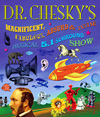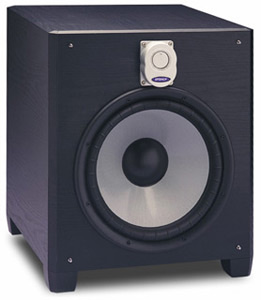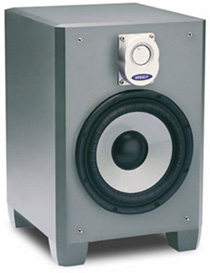![[SoundStage!]](../sslogo3.gif) Surrounded! Surrounded!Back Issue Article |
|||||
March 2005 Energy S8.3 and S12.3 Subwoofers
A poorly performing subwoofer, or one that is not integrated seamlessly into your system, can ruin your sound. I don’t hear this described as a problem nearly as often as I did a few years ago, however. One thing multichannel playback has helped to accomplish is raise the skill level of users to set up and program subwoofers in their own systems. It has also pushed manufacturers to deliver better products. The great thing about buying a subwoofer today -- as opposed to, say, five or six years ago -- is that you can get more bass, lower bass, and easier-to-integrate bass for less money than ever before. Energy’s two new offerings, the S8.3 ($350) and S12.3 ($800), are prime examples. Basics The S8.3 and S12.3 are bottom-ported, forward-firing designs with woofer sizes that correspond with their respective model numbers -- 12" for the S12.3 and 8" for the S8.3. Usefully, the gain, or output-level adjustment, is located on the front panel via a rotary controller that is neatly integrated into the subwoofer’s grille. The rest of the controls are located, more conventionally, on the rear of the enclosure. This arrangement makes sense -- the level control is what you’ll likely need access to most, whereas the other adjustments are of the set-it-and-forget-it variety. The rear-panel controls consist of a crossover-bypass switch (which you’ll use if your processor provides crossover functions), an RCA line-level input for the low-frequency-effects channel, speaker-level stereo inputs, adjustable crossover (50Hz to 110Hz, 18dB/octave) and phase (0 to 180 degrees, continuously variable) knobs, and an Off/Auto/On knob for selecting the power configuration. The S8.3 (16.38"H x 11.03"W x 14.3"D and 25 pounds) contains an internal 100W RMS (400W peak) amplifier, while a 300W RMS FTC (1200W peak) unit powers the S12.3 (19.3"H x 16.46"W x 18.3"D and 47 pounds). Physically speaking, the subwoofers are simple yet attractive-looking. These are vinyl-covered square boxes with beveled edges and form-fitted grilles. Oddly, the S12.3 comes in black only, whereas the S8.3 is available in silver or black, and the S10.3 (not covered here) comes in those two finishes as well. Note to Energy: Some of us don’t hide our subwoofers -- they don't sound their best under an end table -- but rather put them in a more conspicuous place. Please give us both of the color options for all three models. Innovative features
The S8.3 is the entry-level and the S12.3 is the top model in Energy’s bread-and-butter subwoofer line. Despite their reasonable prices, these products incorporate some innovative features evolved through years of building and designing subs. There is no better example of this than the concept of the Elliptical Surround. Before I get to the technical part of that feature, though, it’s interesting to understand why Energy needed to develop such a technology in the first place. In subwoofer land, it’s always beneficial to make more from less -- more bass output from less physical space, specifically. This can be accomplished in a limited number of ways. Principally, output capability can be increased with greater driver surface area and/or greater driver excursion. There are tradeoffs with each approach, however. Greater driver surface area usually means a larger-diameter woofer, and, consequently, a bigger box in which to house it. You just can’t put a big 15" driver in a 12" cube, no matter how slick your engineering department is (at least with the 15" driver intact!). Subwoofers must be domestically feasible devices, so larger boxes are a compromise that most manufacturers like to avoid. That leaves greater driver excursion as a primary area of concentration for increasing bass output. The Elliptical Surround was developed to allow Energy to achieve greater driver excursion with less distortion. As a woofer’s excursion -- the distance the cone travels fore to aft -- is increased, so generally is its distortion. This is a concept most folks can wrap their heads around. Run something close to its limits and it won’t work as well as it would in its comfort zone. Take amplifiers, for instance, where clipping distortion occurs when amps are overdriven. In the same manner, a driver’s distortion increases as the device reaches its maximum excursion. What Energy did was figure out a way to decrease distortion -- they claim from 14% to near 0% in the driver’s operating range -- as their driver reaches its physical limits. The ribbed surface comprising the Elliptical Surround helps keep the physical integrity of the driver intact as it reaches its limits. The surround rejects deforming as it is stretched. In effect, this gives the driver more comfortable operating room before audible and measurable distortion sets in. Energy reports that the S8.3’s woofer is rated for 1.49" peak-to-peak excursion, while the S12.3’s is 1.61" -- impressive numbers that compare to some mighty costly woofers I’ve seen. The second benefit of the Elliptical Surround is that it can be kept to a reasonable size. This means that it doesn’t eat into the woofer’s surface-radiating area (you’ve likely seen woofers where the surround seemingly takes up much of the cone itself). The net result, according to Energy, is that the end user gets more bass and cleaner bass without a bigger box, a bigger driver, or a bigger price. 'Woofing Subwoofers in multichannel systems can be configured for different levels of involvement based on the user’s system, tastes, and bass-management facilities. For instance, in a setup where two-way monitors are used, all the speakers in the system might be programmed to "Small," leaving the subwoofer to not only produce LFE, but also the bass rerouted from all of the other channels. If full-range speakers are used all around, the subwoofer would only reproduce the LFE track -- a much easier job. In my system, with five full-range Paradigm Studio 100 v.3s, I compromised for the sake of thorough testing: The mains were set to "Large," and the center and surrounds to "Small." Therefore each Energy subwoofer reproduced the LFE track and any bass rerouted from the surround and center channels. The rest of my system consisted of a Talk Electronics Hurricane 2.2 multichannel preamp, three Tornado 2.2 stereo power amps, and an Esoteric DV-50 universal audio/video player. Cables and power conditioning were from Shunyata Research. A disc that I’ve found invaluable for testing subwoofer performance is Dr Chesky’s 5.1 Surround Show [Chesky CHDVD272]. This disc is a one-stop shop for bass of all varieties, whether percussion, rocket ships, naturally occurring sounds, you name it. "Fire Drums" and "Bass Drum March" are well suited in establishing whether your room is booming (meaning a bad room interaction) or, conversely, you’re hearing tight, pitch-defined bass. The S12.3 played these tracks with almost no overhang -- all I heard was the percussion, extended and powerful. The bigger of the two subs gave me a sense of great slam and control. The drums were not ultra-tight, but somewhat rounded as the bass rolled through my room with impressive output capability and extension. The sixth track, "The Storm," is of a naturally recorded thunderstorm. The thunder booms, and then trails off with distant yet distinct power. The S12.3 was able to maintain the pressure of the initial crackle, but also showed the definition needed to reproduce the natural decay of the thunder. I heard no evidence of the one-note-bass syndrome -- where bass sounds meld into an amorphous blob -- that can be the scourge of fine subwoofing. For testing sustained power, try "Organ and Chimes." The ability to attain "room lock" -- the sense that a subwoofer is capable of pressurizing a room fully, and sustaining that over a period of time -- is important to pipe-organ music and many naturally recorded sounds such as subways and storms. The organ on this track should sound as if it’s coming through your floors and into the seat of your pants. The S12.3 was able to excite the air molecules in my room fully for a secure, confident room lock on this track. The bass welled up from below my seat and vibrated my entire body. Perhaps the ultimate tests on the Chesky disc are the "Heartbeat" tracks. In increments of 10Hz, from 50Hz on down to 20Hz, these are simply brutal tests for subwoofers and loudspeakers. In fact, there is an "Announcement" track before each one so that the listener knows what’s coming. Lesser subwoofers than these, and many full-range loudspeakers, I’d imagine, could be seriously damaged trying to reproduce these sounds. Imagine a human heart the size of a Hummer beating in your living room and you have a good idea what these tracks should sound like. The S12.3 reproduced the 50Hz, 40Hz, and 30Hz tracks with power and clarity. I did not feel a letdown in bass reproduction as I cycled through these ever-more-difficult-to-reproduce tones -- that is, until I reached the last track. Things did fall apart with the 20Hz tone. The S12.3 just could not manage this track with any kind of audible output power. Remember, though, that 20Hz is lower than most sounds effects and almost all music.
To this point my comments have been strictly limited to the S12.3. At $800 this subwoofer is playing in a crowded field and in my estimation it held up its end of the bargain smartly. You get more than 800 bucks worth of bass with this subwoofer. The S8.3 fills a different niche, however. At $350, it is less than half the price of the S12.3 and much smaller. As to be expected, it can’t play as low, as loudly, or as powerfully as the S12.3. It gives up ground to its big brother on the 30Hz "Heartbeat" track and will barely even make noise with the 20Hz tone. What it can do, however, is provide solid bass and impressive output into the 35Hz range. Although I’d not suggest feeding a loud LFE signal to the S8.3, I would love to hear it paired with a small set of bookshelf speakers. You could, with careful blending, end up with a satisfying, nearly full-range system with the S8.3 and a pair of Energy Connoisseur C-1s, for instance. I was impressed with how the S8.3 reproduced the "Fire Drums" and "Circle of Drums" tracks in my system. Without getting heavy-handed with the volume control, the S8.3 sounded close in performance to the S12.3. The differences between the subs, again, became more apparent with the "Organ and Chimes" track. The S8.3 struggled to attain room lock, but in a smaller room than mine things might improve. Both subwoofers easily handled last month’s Multichannel Pick of the Month, Sarah McLachlan’s Afterglow Live [DVD-Video, Arista 82876-64543-2]. The composed and subtle bass on this disc was a piece of cake. There’s nothing bombastic on this release, but the LFE track does add warmth and substance. The S12.3 and S8.3 reproduced the bass from McLachlan’s latest DVD-V release in a way that added a sense of space and energy to the performance. Whether you choose the S8.3 or the S12.3 will largely depend on your budget, room size, and whether you need a subwoofer that can play full-bore organ music or simply something to augment some bass-challenged bookshelf speakers. There is, however, no sonic downside to going with the larger sub. If you can afford it, get the S12.3 and don’t look back. Summing it up Energy has scored a hit with the S12.3 and S8.3 subwoofers. I found the front-mounted level controls convenient to use and the crossover-bypass switch helpful in setting up the units in my system. The S12.3 is the big winner, with its impressive output capability and pitch-defined bass reproduction. The S8.3 would work well in a smaller room or a less-demanding system where huge output levels at ultra-low-frequencies aren’t required. Energy has delivered good bass at good prices. This is exactly what I was hoping for, and I suspect, a fair number of you were, too. ...Jeff Fritz |
|||||
|
|||||
![[SoundStage!]](../sslogo3.gif) All Contents All ContentsCopyright © 2005 SoundStage! All Rights Reserved |
 If you’ve ever played the
same scene in a movie over and over in order hear how your subwoofer handles one
bass-injected scene, you’ll appreciate this disc. Not only are there many
bass-charged tracks on Dr. Chesky’s Musical 5.1 Surround Show, but there are
also tracks with bass sounds you just don’t hear every day. Some subwoofers can
rumble, but they just can’t punch you in the gut; some subwoofers sound tight, but
can’t charge a room with bass power; and some subwoofers can play back sound effects,
but can’t handle music worth a flip. This disc will let you assess your subwoofer as
you replay all types of tracks. Sound-effects engineers include Bob Katz, Peter McGrath,
Barry Wolifson, Rick Eckerle, and David Chesky -- guys who know how to produce clean,
clear sound. There are subways rumbling, thunderstorms crackling, percussion percussing,
and space ships blasting. You won’t kick back and relax to Dr. Chesky’s
Musical 5.1 Surround Show, but it will come in handy if you’re purchasing a
subwoofer that’ll need setting up or if you want a demo disc (it's available as a
DVD-A and SACD) to show off the one you already have.
If you’ve ever played the
same scene in a movie over and over in order hear how your subwoofer handles one
bass-injected scene, you’ll appreciate this disc. Not only are there many
bass-charged tracks on Dr. Chesky’s Musical 5.1 Surround Show, but there are
also tracks with bass sounds you just don’t hear every day. Some subwoofers can
rumble, but they just can’t punch you in the gut; some subwoofers sound tight, but
can’t charge a room with bass power; and some subwoofers can play back sound effects,
but can’t handle music worth a flip. This disc will let you assess your subwoofer as
you replay all types of tracks. Sound-effects engineers include Bob Katz, Peter McGrath,
Barry Wolifson, Rick Eckerle, and David Chesky -- guys who know how to produce clean,
clear sound. There are subways rumbling, thunderstorms crackling, percussion percussing,
and space ships blasting. You won’t kick back and relax to Dr. Chesky’s
Musical 5.1 Surround Show, but it will come in handy if you’re purchasing a
subwoofer that’ll need setting up or if you want a demo disc (it's available as a
DVD-A and SACD) to show off the one you already have.
